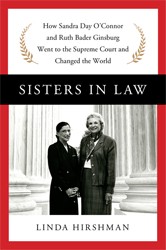When asked how many women would be enough on the Supreme Court, Justice Ruth Bader Ginsburg famously answered “nine,” wryly drawing attention to the previously unquestioned absence of any women on the highest court in the land. In Ruth Objects, Doreen Rappaport and Eric Velasquez inform young readers about the brilliant and compassionate jurist who has fought her whole life for equality, not in order to achieve strict numerical parity for women, but to ensure fairness for all. Education, employment, political participation, and caring for families are areas of the deepest importance to Ginsburg. Rappaport and Velasquez’s story of her unwavering commitment to the Constitution’s protections for all Americans is lively, accessible, and inspiring.
The book’s large size and bold presentation highlight the impressive dimensions of its subject’s achievements, beginning with her portrait on the cover against a background of the Constitution’s preamble. The text is preceded by endpapers featuring the first of the Justice’s quotes which appear on every page, structuring the narrative. In a striking font against a solid background, the statement contrasts with the equally impassioned assertion of the Founding Fathers’ “We the people,” asserting that “Women will have achieved true equality when men share with them the responsibility of bringing up the next generation.” Throughout the book, both text and pictures support the premise that intellect and compassion, as well as work and family, are the inseparable dimensions of Ginsburg’s life. Ginsburg’s journey begins with her mother, a strong woman confronted with the inevitable limitations of her own generation, who encourages her daughter to be strong but to balance persistence with self-control.
Velasquez’s style, a kind of photorealism tempered with emotion, will be appealing to children. Young Ruth’s mother sits in a wooden chair in their modest Brooklyn apartment facing Ruth and firmly laying a hand on her daughter’s shoulder. This opening image captures the book’s central message of female support, continuing to develop in Ruth’s young life as she lights Shabbat candles with her mother and meets other strong role models, Jo March and Nancy Drew, in her weekly visits to the library.
Attending Cornell University, and later Harvard and Columbia Law Schools, the ambitious young woman learns how to navigate the constant obstacles placed by male prejudice in her path. Rappaport conveys this experience to readers who may be unaware of earlier societal attitudes through simple and emphatic sentences: “Harvard treated men and women differently, too…The old periodicals room was closed to women. Only one building where classes were held had a women’s bathroom.” A key turning point is her meeting Marty Ginsburg, the love of her life, whose constant support was essential as she strove to combine her career with motherhood. A smiling wedding portrait and one of Marty in his crisply tailored army uniform is followed by Ginsburg in maternity clothes, her head turned in a frown as she learns that her pregnancy will be the end of her job as a lawyer. Sexism combined with antisemitism makes career advancement improbable, but Ginsburg refuses to accept obstacles as inevitable, finding mentors and working relentlessly.
Rappaport skillfully avoids the pitfall of portraying Ginsburg as a superwoman who somehow defies reality in a way which normal mortals could never hope to imitate. In arguing her first case before the Supreme Court, she was nauseous with anxiety but “felt a surge of power that carried me through.” This power was rooted in her thorough preparation, but also in the fact that her personal goals were intertwined with social ones and that she practiced law in an era when disempowered Americans were beginning to make their voices heard. Fighting for the rights of female custodial workers who had been laid off at Columbia, she faces the workers without a trace of condescension, working together to get equal benefits: “The women won.” Not every fight leads to victory, either in court or in Ginsburg’s personal life, where the loss of her husband was as difficult as the loss of her mother had been when Ruth was a young woman. Readers learn that Ginsburg’s objections were sometimes overruled, but that her struggles and dedication have incalculably bettered the lives of both women and men.
This is a highly recommended biography which includes a timeline, a bibliography, and a list of additional sources, as well as insightful “Notes” by both author and illustrator.
Emily Schneider writes about literature, feminism, and culture for Tablet, The Forward, The Horn Book, and other publications, and writes about children’s books on her blog. She has a Ph.D. in Romance Languages and Literatures.




